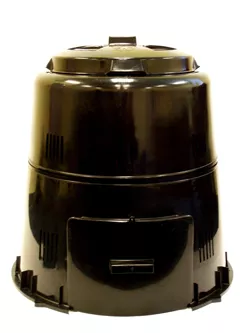Backyard Composting
Useful Information
Learn about the backyard composting process below.
-
Answer
Compost is a dark, earthy material that is created from the natural decomposition of organic matter.
-
Answer
To produce an excellent, free, soil conditioner that will improve soil and the plants growing in it. Backyard composting also reduces waste set out curbside. By composting at home, household curbside garbage can be reduced by 20 to 30 per cent!
-
Answer
Find out where to buy bins, composters and garbage tags at various locations across the City.
-
Answer
- Step 1: Place the container in a level spot on the earth where there is good water

- Step 2: Line the bottom of the composter with heavy-duty wire (optional) and place composter into the shallow hole.
- Step 3: Add organic materials. When adding food waste, either dig it into the existing compost immediately, or cover it well with soil or a layer of leaves. Add both nitrogen-rich green materials, and carbon-rich brown materials. For example, when adding kitchen scraps or grass, also add some dry leaves. Chop or shred materials into small pieces to make the composting process go faster.
- Step 4: Keep the pile moist but not wet - like the dampness of a wrung out sponge. Use a tight-fitting cover to keep the pile from becoming too wet from rainfall. If it gets too dry, water it with a watering can or hose. Using a tight-fitting cover will also keep animals and flies away.
- Step 5: Provide air to the pile by turning it with a pitchfork or shovel, by using a ventilation tool, or by placing an air stack in the center of the pile.
- Step 1: Place the container in a level spot on the earth where there is good water
-
Answer
Apple cores and peels, artichoke leaves, asparagus bottoms, banana peels, beans, beet tops, berries, blood meal, bone meal, bread, broccoli stalks, Brussels sprouts, buckwheat hulls, cabbage stalks and outer leaves, carrot tops and scrapings, celery tops, citrus rinds, coffee grounds and filters, corn cobs (preferably chopped), corn stalks, cotton rags, cucumber skins, eggshells, feathers, 100% cotton or wool felt waste, flowers, garden waste, grapes, grape plants, grapefruit, grass, hair, hay, hops (spent), leaf mold, leaves, lettuce, lemons, melon rinds, onion skins, oats, peanut hulls, pears, peat moss, pineapple cores and skin, pine needles, potato peelings, pumpkins, sawdust, seaweed, soil, straw, string, squash rinds, tea leaves and bags, tomato skins, weeds, wood ash, wool rags, turnip skins, zucchini skins.
Grass: Add grass clippings sparingly in thin layers to compost. Allow the grass to fully dry in the sun before adding.
Leaves: Adding dry leaves in a compost mix helps with the composting process! When raking leaves in the fall, save several bags to add gradually to the pile during the rest of the year.
-
Answer
All animal products and oily foods including butter, bones, cheese, fish (and scraps), lard, mayonnaise, meat (and scraps), milk, peanut butter, poultry (and scraps), salad dressing, sour cream, vegetable oil, yogurt.
-
Answer
A compost pile that is working well should not have an unpleasant odour. If it does, it may be that the materials are too wet or compacted. Turn the pile to let it dry out or add dry materials such as leaves.
-
Answer
The decomposition of compostable material may take anywhere from two months to two years. If the tips outlined here are followed, compost may form within months. Opting for the 'no fuss' method of composting (no mixing, no maintenance) will take longer to produce finished compost.
-
Answer
Yes. Continue to add materials throughout the winter. The decomposition process will slow down, but the pile will become active again in the spring.
-
Answer
When compost is ready to use, it should be dark and crumbly, with most of the original identity of the materials no longer visible. You can screen the finished compost to remove coarse or incompletely decomposed materials such as shells, corncobs or twigs. Return these to the compost pile for another batch.
Dig compost into the earth before planting flowers and vegetables. Use it as mulch to top-dress around plants and trees to help retain moisture, smother weeds and prevent soil compaction. Compost can also be used on lawns as part of a seed-starting mix or a top dressing.
